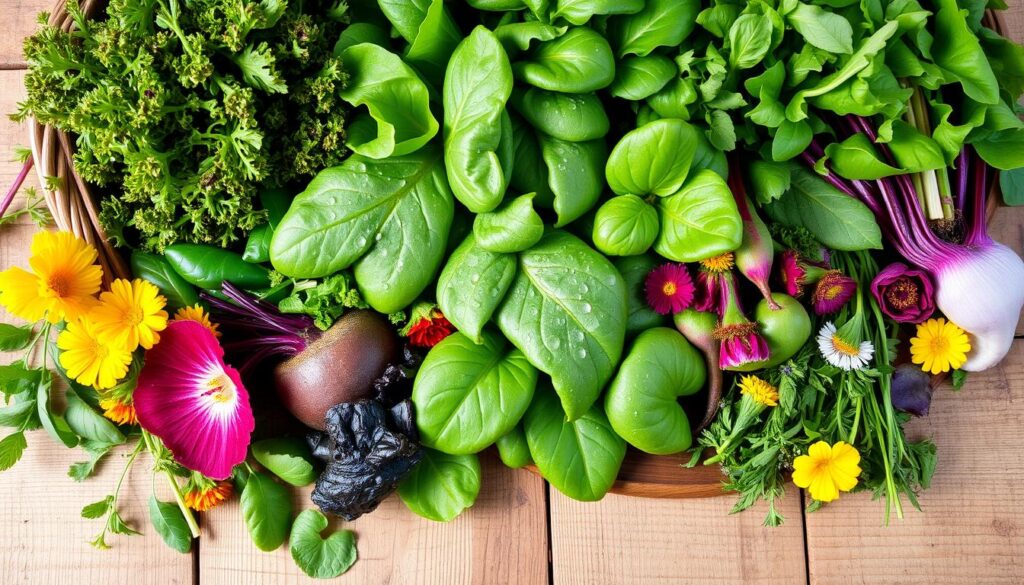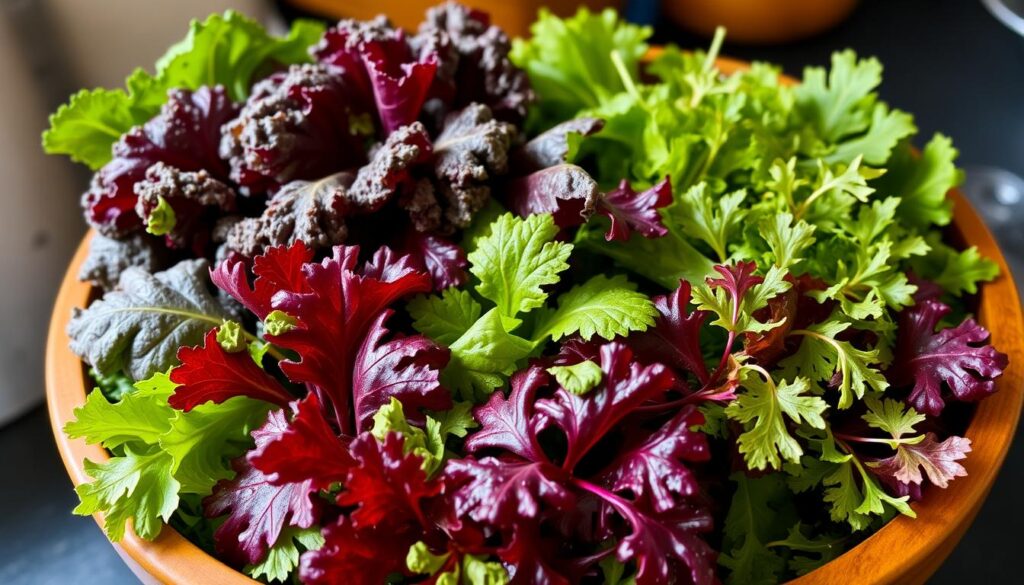This post contains affiliate links.
Ready to add some green to your meals? Welcome to the world of salad greens. These greens are more than just a base for your favorite dressing. They are nutritional powerhouses that can change your meals.
From crisp romaine to tender butterhead, the diverse world of salad greens offers a wide range of flavors and textures. Did you know that two cups of raw baby spinach have only 24 calories? They also have 2 grams of protein and fiber, making them a great choice.
But there’s more! Mixed greens include arugula, kale, and watercress, each with its own taste and nutrients. For example, two cups of raw baby kale have 24 calories, 3 grams of protein, and 3 grams of fiber. It’s a tasty way to increase your nutrient intake.
Before you buy all the greens, remember they have a short shelf life. The best choice is local and fresh greens. So, next time at the farmers’ market, pick up some of these greens. They will help you make your salads even better!
Key Takeaways
- Salad greens offer a wide range of flavors, textures, and nutritional benefits
- Leafy vegetables like spinach, kale, and arugula are low in calories but high in nutrients
- Fresh, local greens typically have a longer shelf life than store-bought options
- Whole heads of lettuce often last longer than pre-cut or bagged varieties
- Proper storage and handling are crucial for maintaining the freshness of your greens
The Little Black Dress of the Culinary World: Introducing Salad Greens
Think of your plate as a fashion runway. Salad greens are like the little black dress of food – they’re versatile, stylish, and always in style. From crisp lettuce to tender leafy greens, they’re ready to shine in your kitchen.
You have many choices, darling! Soft butter lettuce adds a delicate touch, while spicy arugula makes a bold statement. Crunchy romaine gives you that classic look. Mix these greens to create your unique salad style. It’s like adding accessories, but with extra vitamins!
Did you know January is National Soup Month? While soups get all the attention, salad greens are always ready to help. They’re not just pretty; they’re full of vitamins A, C, and fiber. It’s like a spa day for your body!
“Salad greens are the ultimate quick-change artists. They can go from casual lunch to fancy dinner faster than you can say ‘toss and serve’!”
So, next time you’re cooking, remember: salad greens are your secret weapon. They’re quick, easy to pair with other foods, and always get rave reviews. Who knew eating greens could be so glamorous?
Types of Lettuce: Crisphead, Butterhead, and Loose-Leaf
Ready to explore the leafy world of lettuce varieties? You’re in for a treat! From crispy iceberg to tender butterhead, each type brings its unique charm to your salad bowl. Let’s dive into the three main categories of lettuce and discover their delicious differences.
Crisphead Varieties: Iceberg and Romaine
Crisphead lettuces are the sturdy workhorses of the salad world. Iceberg, the best-known member of this family, offers a satisfying crunch and mild flavor. Its cousin, romaine, brings a touch of bitterness and substantial ribs to the mix. Both are perfect for adding texture to your salads.
Butterhead Beauties: Boston and Bibb
If you’re after a more delicate experience, butterhead lettuce is your go-to. Boston and bibb varieties form loose, round rosettes of tender leaves. Their mild flavor and soft texture make them ideal for lighter salads or as a gentle wrap for your favorite fillings.
Loose-Leaf Lovelies: Red and Green Oakleaf
Loose-leaf lettuces are the free spirits of the bunch. Growing in open layers with ruffly leaves, varieties like red and green oakleaf offer a visual feast. These types often have “leaf” in their names and provide a mix of flavors and textures to elevate your salad game.
| Lettuce Type | Texture | Flavor | Best Use |
|---|---|---|---|
| Iceberg | Crisp | Mild | Wedge salads, sandwiches |
| Romaine | Crunchy | Slightly bitter | Caesar salads, grilling |
| Butterhead | Tender | Mild, buttery | Delicate salads, wraps |
| Loose-leaf | Varied | Diverse range | Mixed salads, garnishes |
Remember, when selecting your greens, look for fresh, firm leaves without browning. A quick 15-minute soak in cold water can revive slightly wilted lettuce. Dry your leafy friends completely before storing them in the fridge to keep them crisp and ready for your next culinary creation.
Beyond Lettuce: Exploring Other Leafy Vegetables
Explore the world of leafy greens beyond lettuce! Your salad bowl is about to get exciting. Arugula adds a peppery kick, while spinach is versatile in both baby and mature forms. Kale, especially the tender baby variety, is packed with nutrients.
Watercress brings a fresh, pungent flavor with a hint of heat. Mesclun blends offer a mix of tender young greens. Microgreens, the tiny powerhouses of flavor, can elevate any dish. Chicories like endive and radicchio add a delightful bitterness and crunch to salads.

- Malabar spinach: Quick-growing with large leaves
- Tatsoi: Forms rosettes close to the ground
- Upland cress: Zesty and nutritious
- Purslane: Rich in omega-3 and antioxidants
- Sorrel: Lemony flavor, perfect for soups
Did you know? Chefs are getting creative with salads, using shaved beets, spiralized veggies, and unique ingredients to boost flavor and texture. The veg-centric trend is pushing salad innovation to new heights!
“Salads are the perfect canvas for culinary creativity and menu differentiation.”
| Green | Flavor Profile | Best Use |
|---|---|---|
| Arugula | Peppery | Raw in salads, wilted in pasta |
| Spinach | Mild, slightly sweet | Raw or cooked, versatile |
| Kale | Earthy, slightly bitter | Massaged raw, sautéed, or in smoothies |
| Watercress | Pungent, peppery | Salads, sandwiches, soups |
| Frisée | Bitter, crunchy | Mixed salads, pairs well with soft greens |
Ready to reimagine your salads? Mix cool-season greens like minutina with warm-weather favorites like purslane. You’ll create a tasty and nutritious salad that’s sure to impress. Remember, the key to a great salad is variety – so don’t be afraid to experiment with new leafy vegetables!
Nutritional Powerhouses: Health Benefits of Salad Greens
Ready to supercharge your health? Dive into the world of salad greens! These leafy wonders are packed with vitamins, minerals, fiber, and antioxidants that’ll make your body sing with joy.
Vitamins and Minerals Galore
Salad greens are like nature’s multivitamin. They’re bursting with essential nutrients that keep your body running smoothly. Check out these vitamin K superstars:
- Kale: 68% of your daily value in just one cup
- Spinach: A whopping 121% in a single serving
- Collard greens: An impressive 131% per cup
But that’s not all! These greens are also rich in vitamins A, C, and E, plus minerals like potassium, calcium, and iron. It’s like a nutritional party in your bowl!
Fiber-Rich and Low in Calories
Want to feel full without the guilt? Salad greens are your new best friend. They’re packed with fiber, which aids digestion and keeps you satisfied. Plus, they’re super low in calories, making them perfect for weight management.
Antioxidants and Disease Prevention
Salad greens are like your body’s personal bodyguards. They’re loaded with antioxidants that fight off free radicals and help prevent chronic diseases. From boosting your immune system to supporting heart health, these leafy heroes have got your back.
| Salad Green | Vitamin K (% Daily Value) | Other Benefits |
|---|---|---|
| Kale | 68% | High in vitamin C, antioxidants |
| Spinach | 121% | Rich in iron, folate |
| Collard Greens | 131% | Excellent source of calcium |
| Romaine Lettuce | 40% | High in vitamin A, low in calories |
| Arugula | 18% | Spicy flavor, cancer-fighting compounds |
So, next time you’re crafting a salad, remember: you’re not just making a meal, you’re building a fortress of health!
The Salad Green Rainbow: Colorful Options for Your Bowl

Say goodbye to boring salads! It’s time to add color to your bowl with vibrant greens. You’re about to explore a rainbow of leafy greens that make meals nutritious.
Start with the classics like crisp romaine, tender butter lettuce, and peppery arugula. But don’t stop there. Add ruby-red radicchio or purple kale for color and nutrients.
For a milder taste, try watercress or baby spinach. These greens are packed with nutrients without overpowering other flavors. For a zesty kick, add mustard greens or endive.
“Rainbow salads are feasts for the eyes and taste buds.”
To truly embrace the rainbow, consider these colorful additions:
- Red: Cherry tomatoes, strawberries
- Orange: Carrots, mandarin oranges
- Yellow: Bell peppers, corn
- Green: Cucumber, avocado
- Blue/Purple: Red cabbage, blueberries
Mixing different colored greens and veggies makes your salad stunning. It also ensures a variety of nutrients in every bite. This variety is crucial for a balanced diet.
Remember, your salad can change with the seasons. Spring brings tender greens, while fall offers hearty chicories. Embrace seasonal changes to keep your salads exciting all year.
With these colorful greens, you’re on your way to creating beautiful, nutritious bowls. So, go ahead and unleash your inner salad artist!
Salad Greens: From Farm to Table
Fresh greens start their journey from the farm to your table. They go through careful steps of cultivation and handling. Let’s look at how to pick, store, and prepare these healthy greens for your meals.
Selecting the Freshest Greens
When picking fresh greens, look for bright colors and crisp textures. Crisphead lettuces should feel heavy for their size. Loose-leaf greens should not wilt. Fresh greens mean more nutrients and taste in your salads.
Proper Storage Techniques
Storing greens right is key to keeping them fresh. Put them in plastic bags in your fridge’s crisper drawer. Crisphead and romaine can last up to a week. Delicate greens stay fresh for about five days.
| Lettuce Type | Storage Duration | Storage Method |
|---|---|---|
| Crisphead | Up to 7 days | Plastic bag in crisper drawer |
| Romaine | Up to 7 days | Plastic bag in crisper drawer |
| Delicate varieties | Up to 5 days | Plastic bag in crisper drawer |
Washing and Preparing Your Greens
Washing greens right is important for safe and tasty salads. Soak them in cold water for at least five minutes to clean them. Use a salad spinner or gently blot with a towel. This makes sure your greens are clean and ready for your favorite recipes.
By following these tips, you’ll enjoy crisp, flavorful salads. Fresh greens are the base of a great salad. So, take good care of them!
Mixing It Up: Creating the Perfect Salad Green Blend
Ready to take your salad to the next level? Making the perfect mix of greens is simple. Begin with 5 cups of loosely packed salad blends. This colorful base is where your salad magic starts.
Add some excitement with different toppings. Sprinkle 2 tablespoons of sunflower seeds for a nutty crunch. Add ¼ cup of crumbled bacon for a savory touch. Thinly slice ¼ red onion and 1 cucumber to add freshness and texture.
Time to dress it up. Make a tangy honey-mustard vinaigrette in no time. Mix ¼ cup each of dijon mustard, honey, and apple cider vinegar. Season with salt and pepper, then slowly whisk in ¼ cup of olive oil. This dressing will enhance your greens perfectly.
| Ingredient | Amount | Purpose |
|---|---|---|
| Mixed greens | 5 cups | Base |
| Sunflower seeds | 2 tablespoons | Crunch |
| Bacon | ¼ cup | Savory flavor |
| Red onion | ¼ | Sharp taste |
| Cucumber | 1 | Freshness |
This salad serves 6 and is ready in 15 minutes. Each serving has 179 calories, 15g carbs, and 4g protein. It’s a healthy choice that’s full of flavor. The secret to a great salad is mixing textures and tastes. So, mix it up and make your own perfect salad green blend!
Dressing Up Your Greens: Complementary Toppings and Dressings
Ready to make your salad pop? Let’s explore salad toppings and healthy dressings. Imagine a bowl of crisp greens waiting for excitement. It’s time to find the perfect match!
Romaine lettuce meets Caesar dressing, a match made in heaven. Spinach and bacon dressing are a perfect pair. And arugula and sweet vinaigrettes? They’re a love story!
But there’s more than just leaves and dressing. Add some magic to your salad. Pumpkin seeds bring protein and zinc. Sliced almonds add fiber and vitamins.
Dried apricots add a sweet touch and vitamin A. They make your salad a feast for the eyes and taste buds.
Now, let’s talk about dressing. It’s the final touch to your salad. A tangy balsamic vinaigrette makes arugula shine. Creamy dressings like ranch or blue cheese are perfect for crunchy greens.
And if you’re growing a summer garden, use fresh herbs for a light dressing. The right dressing can turn your salad into a hit. So, dress it up and enjoy!
FAQ
What are the main types of lettuce?
What other leafy vegetables can be used in salads?
Why are salad greens so nutritious?
What are the benefits of eating a variety of colorful greens?
How do I select and store fresh salad greens?
How can I create an interesting salad green blend?
What are some healthy salad toppings and dressings?
This post contains affiliate links.

